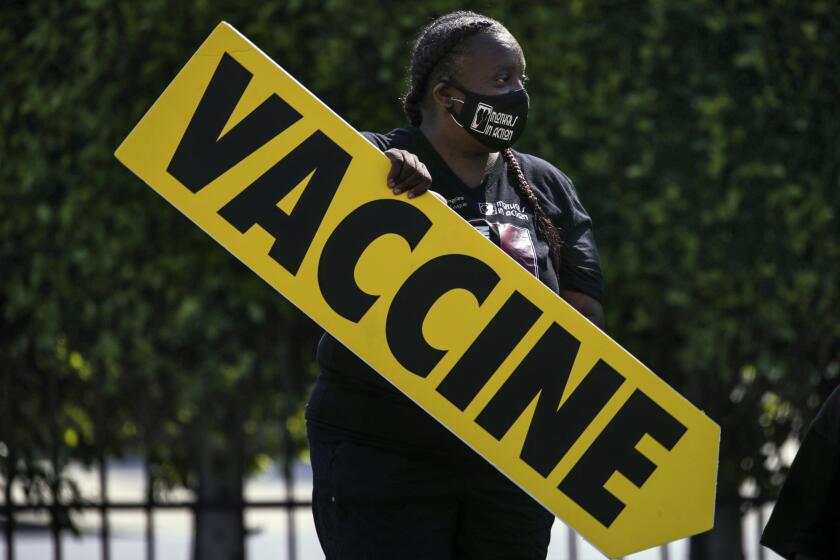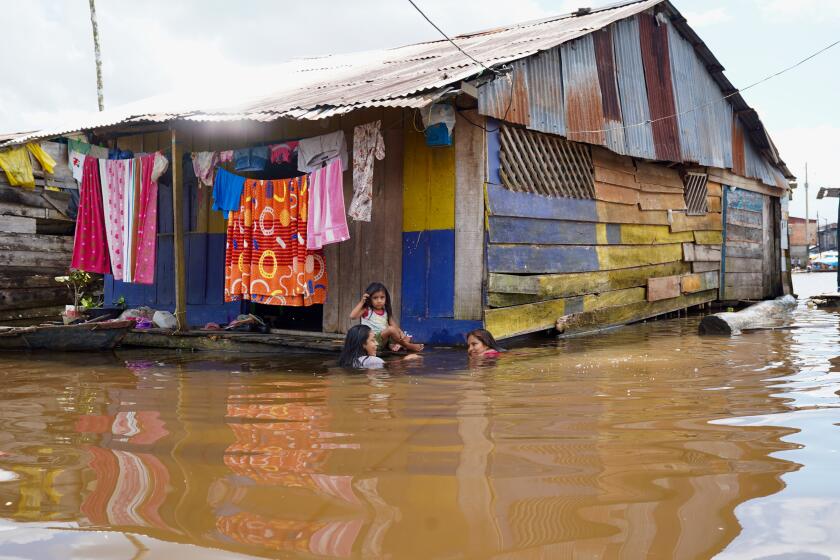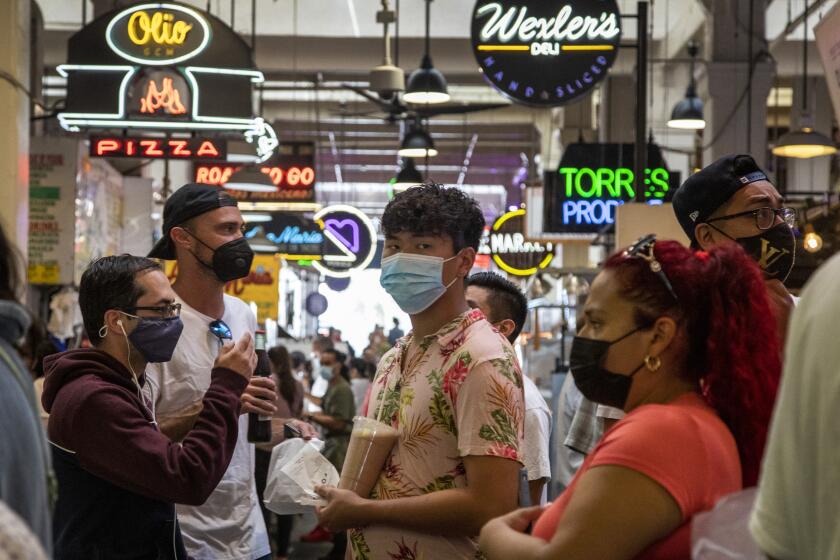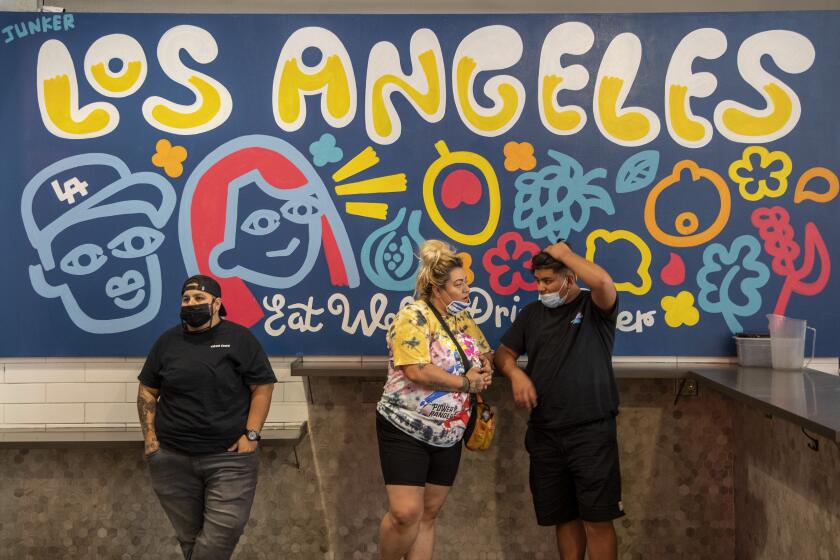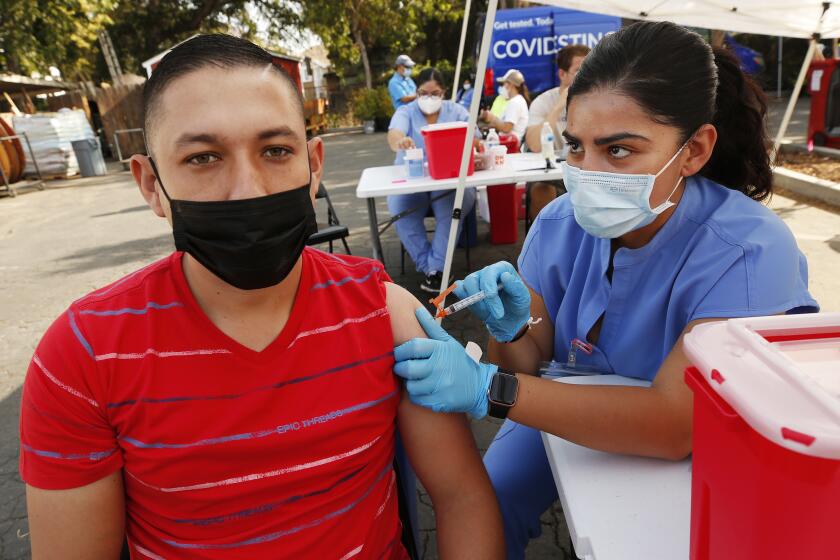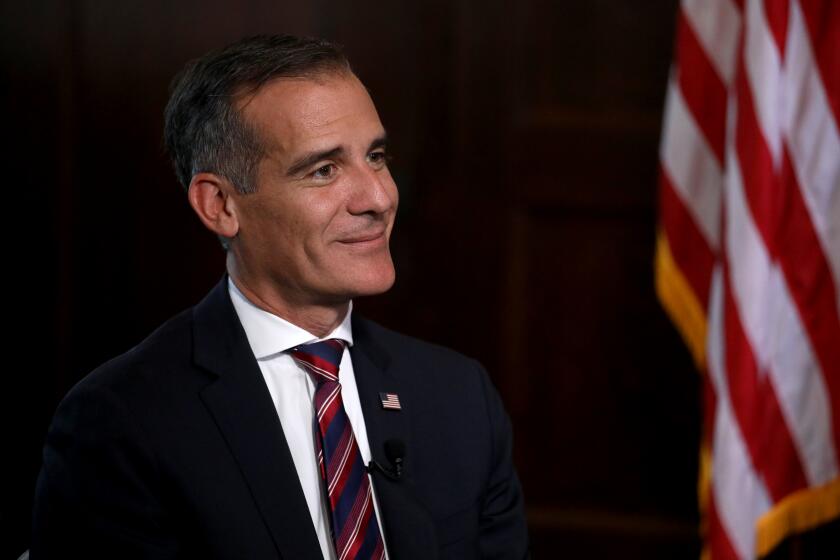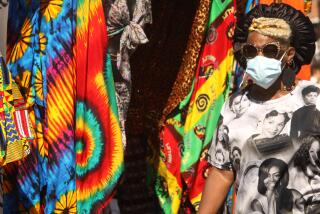‘Breakthrough’ COVID-19 cases rising in L.A., but the vaccinated are still protected, data show
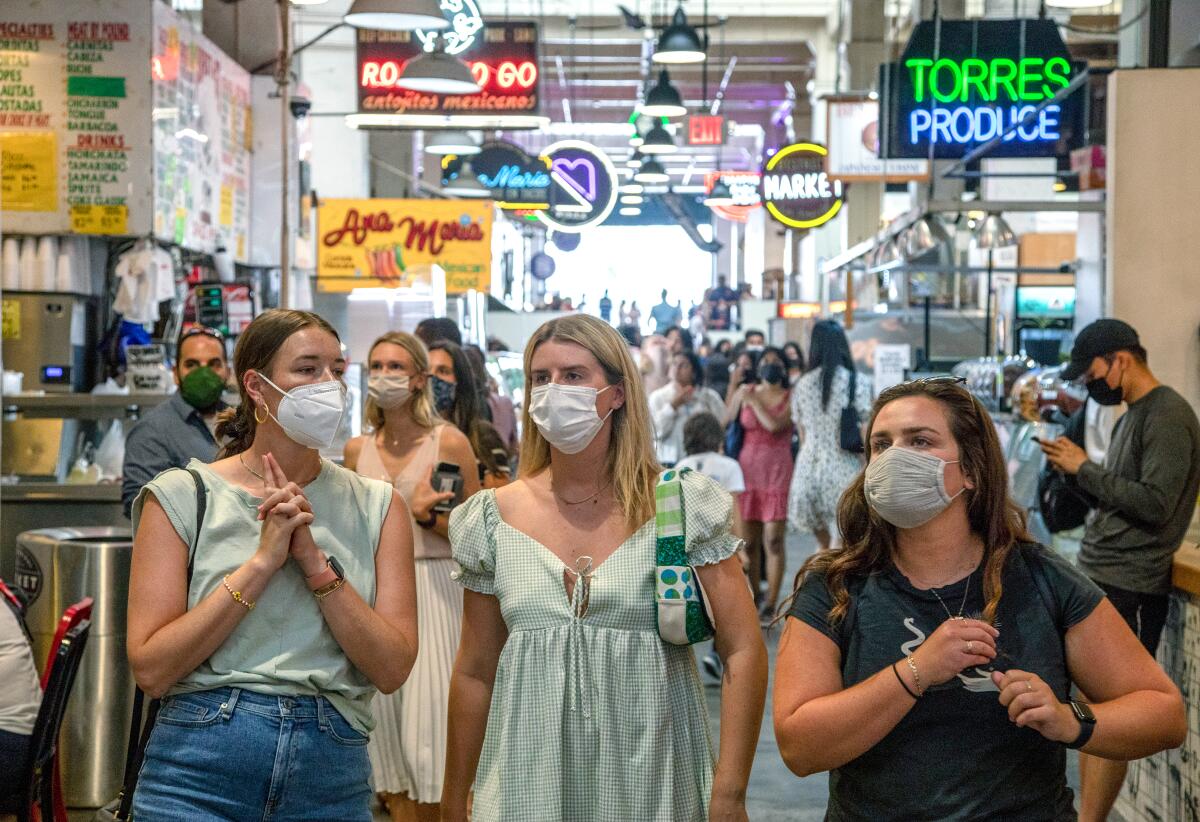
- Share via
Los Angeles County has seen a rise in “breakthrough” coronavirus cases as of late, but data continue to show those who are vaccinated for COVID-19 enjoy vigorous protection — even from the contagious Delta variant — and are far less likely to be hospitalized should they become infected.
The latest figures underscore how the county’s recent coronavirus surge is different from the pandemic’s earlier spikes, both in terms of who is getting sick and how the virus is spreading countywide.
In June, fully vaccinated residents made up 20% of all confirmed coronavirus infections in those 16 and older, according to figures from the Los Angeles County Department of Public Health.
However, that same month, they accounted for only 8% of all COVID-19 hospitalizations.
In June, 20% of Los Angeles County’s coronavirus cases were among fully vaccinated residents. But that doesn’t tell the full story.
That trend has persisted into July. Over the first half of the month, roughly 26% of all diagnosed cases were in fully vaccinated residents, according to figures county Public Health Director Barbara Ferrer presented this week.
This means unvaccinated residents still accounted for almost three times as many infections, even though they’ve been a minority of the population since the start of the month.
And despite the uptick in post-vaccination “breakthrough” cases, the proportion of those people becoming sick enough to require hospitalization over the early part of this month remained essentially flat from June.
“Although vaccinated people are seeing a rise in new COVID diagnosis, they are primarily experiencing their infections not as severe illnesses that bring them to the emergency room, but as bad colds,” Ferrer said this week.
Those who are unvaccinated, she continued, “simply do not have the same level of confidence if they get infected with this virus that it will lead to mild illness.”
Out of the 504 people who died of COVID-19 countywide from April 1 to June 30, 96% were either unvaccinated or had not completed their inoculation regimen, data show.
County health officials are trying to better understand the factors, such as being immunocompromised, that may put fully vaccinated people at risk of dying from COVID-19, Ferrer said.
The pandemic made the poor of Latin America poorer and set back a fledgling middle class throughout the region, threatening a generation.
The rise of vaccinations is also shifting the trajectory of this summer spike. In previous surges, lower-income, densely populated areas were hardest hit as essential workers got COVID-19 on the job and then spread it at home. Areas such as East Los Angeles, the northeast San Fernando Valley and South Los Angeles saw some of the worst spread.
This time is different.
As of July 17, communities that had high rates of transmission included downtown Los Angeles, West Hollywood, Beverly Hills, Venice, Hollywood Hills and Studio City, Ferrer said.
“These are different communities from those with high case rates during our previous surges,” she said. “So far, it appears transmission in these areas is being driven mostly by community spread among young adults.”
In some areas, she added, “there were several smaller outbreaks among persons experiencing homelessness that also may have contributed, just slightly, to the higher rates. And we also have noted that there have been outbreaks in some of these communities at food and bar establishments that also are contributing to the higher rates.”
More than 53% of Angelenos have now been fully vaccinated, according to data compiled by The Times.
With California’s coronavirus surge worsening, officials are unveiling new rules and redoubling efforts to get more people to wear masks in an urgent push to boost vaccinations and slow the spread of the Delta variant.
Health officials have said it’s not unexpected that some people would become infected even after being fully vaccinated.
“Infections after vaccination are expected. No vaccine is 100% effective,” Dr. Anthony Fauci, the U.S. government’s top infectious diseases expert, said last week. “However, even if a vaccine does not completely protect against infection, it usually, if it’s successful, protects against serious disease.”
Ferrer said the disparity in infection and hospitalization rates underscores how much higher the risk is for those who have yet to roll up their sleeves — especially in an environment where community transmission is on the rise.
Over the last week, the county has reported an average of about 2,400 new coronavirus cases per day, The Times’ data show. That’s more than six times the rate seen at the beginning of the month.
But if no one was vaccinated, Ferrer said, daily case counts could perhaps be twice as high as they are now.
“So instead of averaging 2,400 daily cases this past week, our daily case numbers might have instead been closer to 5,000,” she said.
Overall, 991 coronavirus-positive patients were hospitalized countywide on Wednesday, a more than threefold increase from the start of the month.
The new recommendation appears to be more expansive than the latest guidance from the U.S. Centers for Disease Control and Prevention.
L.A. County isn’t an outlier. Across the state, health officials are noting the existence of large gaps between the infection and hospitalization rates of those who are vaccinated versus those who aren’t.
From July 14 to 20, the average coronavirus case rate among unvaccinated Californians was 20.7 per 100,000 people per day — about six times the comparable rate of vaccinated individuals, according to the state Department of Public Health.
Dr. Wilma Wooten, San Diego County’s public health officer, employed a common refrain this week: “This is turning into the pandemic of the unvaccinated.”
“The more contagious Delta variant is on the rise, and being fully vaccinated affords the best protections against the disease,” she said in a statement.
The highly transmissible Delta variant is a more formidable foe than previously believed, largely due to its ability to infect and be spread by people who are fully vaccinated, according to data gathered by the Centers for Disease Control and Prevention.
A confidential document prepared by the agency cites evidence from a recent outbreak in Massachusetts involving at least 145 people who were infected with the Delta variant, which was first detected in India. In the Massachusetts outbreak, the viral loads of the 80 people who were vaccinated were essentially the same as the viral loads of the 65 people who were not vaccinated.
Over the last week, California has reported an average of nearly 7,500 new coronavirus cases a day — more than eight times the rate from four weeks ago, according to data compiled by The Times.
On Wednesday, 3,605 coronavirus-positive patients were hospitalized statewide, with 784 of them in intensive care. Both those figures have doubled over the last two weeks.
Despite the steep rises, though, California remains well shy of the harrowing heights of the fall and winter surge, when an average of more than 40,000 cases were being reported daily and nearly 22,000 COVID-19 patients were hospitalized.
COVID-19 deaths also have remained relatively low statewide — about 28 per day, on average.
With cases and hospitalizations spiking, the focus is increasingly on ramping up vaccinations to protect as many people as possible against infection and illness.
Officials have said there are probably several factors fueling the latest surge.
A major one is the presence of the Delta variant, which is thought to be twice as transmissible as the conventional coronavirus strains.
That variant has rapidly become the dominant strain circulating in California. Given how readily it spreads, experts say it preys particularly easily on those who have yet to be fully vaccinated.
Another likely contributor, though, is behavior. The pandemic’s latest wave began to materialize in the aftermath of California’s June 15 reopening, which saw the state lift many restrictions that had been put in place to stymie transmission of the coronavirus.
Residents had additional options to mingle and mix — providing more opportunities for the virus to spread, particularly among younger, unvaccinated people.
L.A. will require city employees to provide proof of vaccination against COVID-19 or undergo weekly testing for the virus.
Earlier this month, Fauci cited data showing the Pfizer-BioNTech and Moderna vaccines were 95% and 94% effective, respectively, versus symptomatic COVID-19. And in the United States, the single-shot Johnson & Johnson vaccine has been 72% effective against clinically recognizable disease.
So far, L.A. County hasn’t seen a huge divergence in breakthrough infections by vaccine type.
As of this week, only 0.27% of people fully vaccinated with the Johnson & Johnson vaccine had later become infected — compared with 0.15% of Pfizer-BioNTech recipients and 0.09% of those who got Moderna.
Ferrer said the figures are more “compelling evidence on how effective the vaccines are.”
“We can feel very confident saying that all three vaccines continue to perform well protecting people — particularly from serious illness and death and certainly even from getting infected,” she said during a briefing call with reporters.
More to Read
Sign up for Essential California
The most important California stories and recommendations in your inbox every morning.
You may occasionally receive promotional content from the Los Angeles Times.
